 |
 |
 |

September / October 2005

Barcoding and RFID
Automatic Identification
By Judith M. Inglesby, RN MN; Tom Inglesby
Two automatic identification technologies, neither "new" in the sense of being recent developments, are vying for acceptance in the healthcare field. Both have a long and somewhat varied history in other applications, primarily in retailing, manufacturing, and warehousing, and have been getting generally good reviews among the hospitals where they are employed. The two technologies, barcoding and radio frequency identification (RFID), perform similar functions but in significantly different ways.
Lines and Spaces
Barcodes are very common in every walk of life. The technology of creating and reading these "zebra stripes" has been developed to the point where small, relatively inexpensive printers can do a fine job making the labels and handheld scanners, wirelessly connected to a database, can read the codes with near perfect accuracy.
There are surveys that say only 5% of hospitals are even beginning to use barcodes. "I think from what we've seen in the industry, that's starting to change rapidly," claims Sandra Trakowski, vice president and chief nursing officer of Care Fusion, McLean, Virginia. "As more products are introduced to the market, the capabilities are being proven. It's taking time but happening at a faster pace." Two areas have the highest acceptance of barcoding: pharmacy inventory management and patient tracking. Let's start at the pharmacy.
Donna Lee, market intelligence specialist, Handheld Products, Skaneateles Falls, New York, comments, "Pharmacies utilize the barcodes that come on the pharmaceuticals in unit-of-dose packaging. They're also taking the bulk meds that come in, breaking them down, putting them in unit-of-dose and then applying a barcode to them. A very efficient pharmacy would have barcoding on everything — I've visited several that operate like that."
Trakowski adds, "We are also seeing it in laboratories, for specimen collection and positive patient identification. We've just introduced a product in the last six months that has to do with blood care and administration. We're seeing more of that because of patient safety perspective in that arena."
An extension of this is using barcodes with automated equipment such as infusion pumps. At George Washington University Hospital in Washington, DC, Barbara Jacobs, director of critical care, explains their system. "A physician puts an order in the computer, and we send it directly to the pharmacy. The pharmacy produces a label and mixes the bag and sends it up to us. There are some exceptions on true emergency cardiac arrest type drugs when we don't have time to go the pharmacy and back but for the standard drug, we're able to do that.
"The nurse goes to the bedside, scans his or her badge — which identifies that person as an authorized user — and scans the patient's ID, then the bag. The nurse then matches the patient to the bag and scans the bag to set the B. Braun IV pump. The name of the drug appears, the concentration appears, the rate appears and then at the final step, the nurse has to say 'Yes, this is correct' before the pump will start running."
Patient ID
Barcodes, whether used in the pharmacy or at the bedside, are not loaded with personal or medical data. They limit the privacy concerns by being nothing more than an identifier, a number in machine-readable form. "A barcode is just like the license plate on your car," says Rick Hodge, vice president of InfoLogix in Hatboro, Pennsylvania. "With a barcode you get a set of numbers that relate to a record in a database, so when you scan that barcode it goes back to a central database and comes back to you and says it's John Doe. You scan the drug, the drug has a license plate on it that was input in the database with the med, 'There's not been any other drugs administered in the last 12 hours, go ahead and give it to him.'"
The wristband must be durable, easy to print and wear, and not subject to misreading by the scanner. One company providing the material for these is Endur ID, Haverhill, Mass. Bob Chadwick, president of Endur ID, says, "A wristband in a hospital goes through quite a bit of abuse. It has to stand up to the patient, environmental issues such as chemicals, and they have to be comfortable. They have to support a crisp barcode and the barcode has to survive all of those things. The wristband, although it seems like a fairly simple thing, takes quite a bit of work to meet all those needs and meet the price point hospitals demand."
He continues, "One of our cornerstones has always been the use of color photographs and color warnings and alerts. In many hospitals you'll see people wearing five different bands, one for allergies, one for this warning and one for that. We combine it all into one. We put the two identifiers, allergy and alert warnings, color coding for departments or wards, color code for gender, and we can add a photograph — in pediatrics perhaps one of the mother, father, parent, or guardian. We also put hospital logos on and in veteran's administration facilities we actually put the branch of service on the band."
All that on a 0.75 inch ribbon of plastic around the wrist.
Inventory Control
Another use for barcodes in the hospital is to maintain control over assets. As Hodge explains, "A hospital that has 500 beds might have 95 IV pumps. Those pumps have to go through preventive maintenance every 6 months. If you ask them where all their IV pumps are, 50% of the time they won't know where 30% of the pumps are. They won't know when the last time they were maintained. If they're not maintained, when they go to use them and the readings are not correct, it could potentially hurt a patient."
He also mentions another use: "When nurses are delivering care to patients, they go into the nursing closet and get several items. Today they have a sticker they pull off and stick it on their uniform. That sticker stuck to them reminds them to put it into the patient's record. When all that material is barcoded and they have a terminal set up in the nurse's closet with a barcode reader, any time that nurse takes something to the patient it records it real-time."
Portable Readers
Popular personal digital assistants (PDA) such as the Palm Treo are often outfitted with barcode readers, adding to their utility. Steven McDermott of Bio-Logics, West Jordan, Utah, worries about this trend. "First the unit cost of most Palm-based devices is still prohibitive for most facilities," he explains.›"In order to effectively use these units with a barcode system, each person who interacts with a patient will have to have easy access to, or be provided with, their own PDA. Or as it has been suggested, a PDA could be located at each patient's bedside for easier accessibility. In any case, the expense for just these units, excluding software, interface, and service contract costs could easily reach into the hundreds of thousands of dollars for a small- to medium-sized hospital."
The durability of PDAs must also be a consideration. Hospitals operate 24 hours per day, 7 days per week, year-round. This places an enormous burden on the facilities and the equipment in use.›Anything that is taken into an infectious isolation room, for example, must be sterilized before it can be returned to service in the general population. So far, no PDA available at retail would survive repeated sterilization using any current methods.
At Care Fusion, Trakowski disagrees, "We use a PDA from Symbol Technologies called the PPT8846. It weighs 11 ounces, which is pretty light when you consider its capabilities. It is ruggedized — can be dropped to concrete from four feet and not break — and it can be immersed in water and fluids and not be destroyed. It can also be cleaned with your normal infection control type cleaners in the hospital. That's critical to it being able to survive in that environment."
Making Waves
Radio frequency identification (RFID) systems are composed of passive or active tags with embedded chips that allow a radio wave to detect them, read data from them, and in the case of re-writable tags, change the data to update or modify the content.
According to McDermott at Bio-Logics, "While the RFID technology is still relatively new, it may eventually replace barcodes. Our discussion with hospital managers, however, reveal a limited appeal of RFID technology in its current state.›Still, there are a few areas where RFID could provide some significant benefits today. For example, infectious isolation — verification could be done from just outside the room or contaminated area, eliminating the need to cleanse or sterilize the device."
Another area is in the surgery. Many procedures, like a liver operation, require that the patient be draped and then the drape is tucked in underneath the patient's torso. This usually makes any access to an ID band for scanning impossible. Lifting the drape to see or scan the ID band would invade the sterile field and is not allowed. If an RFID device were available, the ID band could be scanned right through the surgical draping and allow for positive verification during the procedure.
One of the early applications of RFID in hospitals has been patient locator systems. Awarix, Birmingham, Alabama, makes a system to track patient movement using RFID technology. CEO Gary York explains, "Our basic approach is to address operational efficiencies and capacity management issues. The first approach is tracking patients using an active tag. At this point we're using it at entry and exit points from units because we want to know what unit a patient is in. We can determine the patient is in the different units or in their room or on the floor of their unit. We get this general information about patient location and use that to help inform the staff about where patients are at any moment."
He adds, "We have a Geo Spatial Visualization map metaphor, and on that map of the hospital, unit or floor we show the key information about patients and their status, as well as process information about patient flow. Because it's a map metaphor we can also show the location of assets or staff members. There are two different views: One is a private view where I see information I'm authorized to see. The other is a public view that we would put into a public area like across from a nursing station or in a public hallway somewhere. The private view can show PHI if you're authorized to see PHI (protected health information). The public views don't show any PHI, they just show general information that you might see on a white board or a piece of paper."
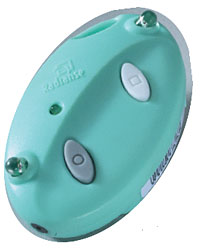 |
|
Facilities with large ambulatory patient populations who might become lost if allowed to leave the premises (long term care or nursing home facilities) could also utilize the RFID chips as patient access control devices and prevent unauthorized exits resulting in lost and disoriented patients.
One patient application is in pediatrics. Irwin Thall, RFID manager for healthcare at Precision Dynamics Corp., San Fernando, California, says, "Infant protection systems are RFID, and they've been around for quite some time. On the passive side, with patient wristbands, we've done about half a dozen pilots this year, and we expect to see increased roll out going forward into 2006. In addition, in the cath lab there are a number of smart cabinets where they put RFID labels on the stents and they're tracked, organized, and inventoried. So you have some passive technology both on the patient side and on some high value date-sensitive products like some of the new stents that have expiration dates."
Thall also notes that RFID won't replace barcodes any time soon. "I think barcodes are appropriate where cost is an issue. For instance, draw tubes. Barcoding suffices in that application very nicely, but you can drive the creation of those barcode labels at the bedside by reading an RFID wristband that's on the patient. You would have two complementary technologies in the same space. You'll have the technologies existing side by side going forward."
Wraps and Radio Waves
The two elements that are needed in an RFID system are the tags and the interrogator or reader. Like barcodes, the data is cross-referenced to a database where the patient information is held. The tags for patients are usually in the wristband although some experiments are being done with under-the-skin implants for long-term patients such as those suffering from dementia.
DataRay of Oklahoma City manufactures high-quality printers for wristband generation, including those with RFID capabilities. Brent Scales, DataRay's sales manager, comments, "We've taken thermal label printers, which we consider a higher quality product for printing wristbands, and designed an extra hardware interface that allows them to communicate with the hospital information systems."
Scales continues, "They print out a patient wristband with RFID and/or barcode and all the other information they need. By having hardware that is designed to natively plug and play with their system, they can be up and running printing RFID wristbands in a week."
Thall adds, "We're trying a number of different applications. We're using the read/write capability to store surgical sites for patients before they go into surgery. We're also doing some things in the OR, in terms of matching units of blood to the patient. What we're looking at now is working with companies that have devices that need to acquire patient identification and we're making it easier for those devices to capture that information from an RFID wristband. For instance, once you've typed in a cross match, they could store your blood type on the wristband and they don't have to continuously keep referring to the records or keep typing you and cross matching it."
Jim Kohler, a director of Sculptor Development Technologies (SDT), Canonsburg, Pennsylvania, describes an ideal system, "Our application runs on a PDA, and the nurse uses it at the patient's bedside. We identify three different things with our application. The first is the user, or the nurse. The second is the patient. The third is the medication. We see RFID as having an application for the identification of the nurse or user and the patient. We see that in the nearer term and then longer term it could become a technology that's used to identify medications."
He goes on to say, "With the nurse having a PDA and recognizing that we're going to have barcodes on meds for quite some time, it's safe to assume that the PDA would need to have both a RFID reader and a barcode reader built in. Another piece of the puzzle would be something that can create the RFID tag that the nurse or patient is going to be wearing. Our application has the ability to print on a label and encode an RFID tag that is embedded in that label."
Maybe not now, but soon, hospitals will have a number of ways to automate their patient, staff and medication tracking. It's a growing field.
Judith Inglesby, RN MN, is a registered nurse and a member of the patient safety committee at Palomar Medical Center, Escondido, California.
Tom Inglesby is an author who has covered data collection technology since the early 1980s.
- SPECIAL SECTION:
Barcoding and RFID

|
 |
 |
 |


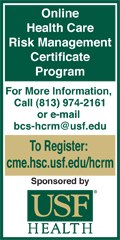





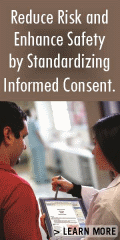

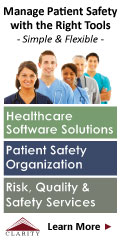

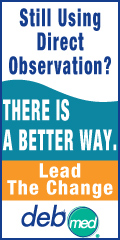





|
 |



